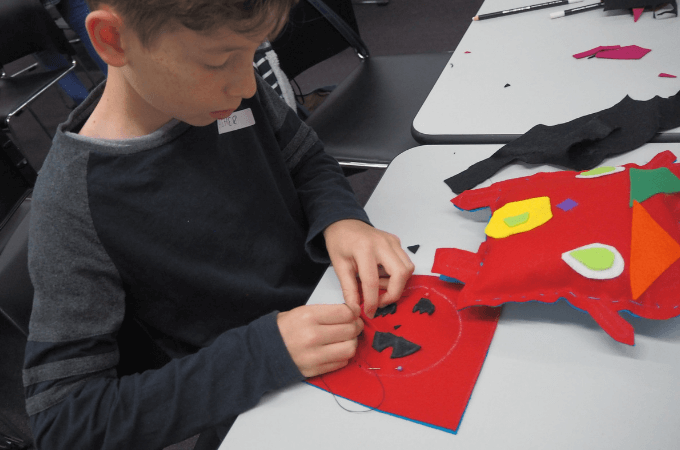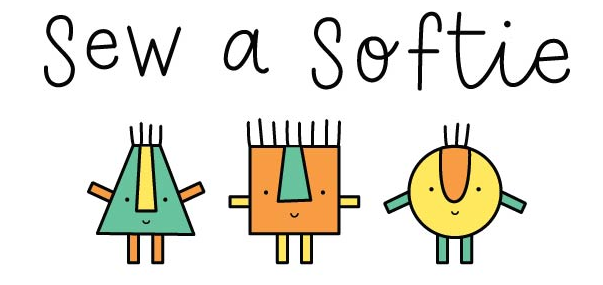Teaching Kids to Sew and the Essential Stitches I Use
In Part 1 of my Sewing with Kids Guide I talked about the essential supplies you need when teaching kids to sew.
In Part 2 I want to talk about teaching kids to sew essential stitches. These are the stitches I teach to kids in my workshops. I have to admit that my all time favourite stitch to teach kids is the good old running stitch.
Two things make the running stitch a good place to start: firstly, it’s easy to master and secondly, it’s a fairly quick stitch to sew. It’s certainly quicker to use than a backstitch or overcast stitch. When kids start to sew I think it’s really important that they find sewing easy and that they can finish their project within a reasonable amount of time. A running stitch is perfect on both counts. Having said that, you will find kids that just love the feeling of doing a backstitch or an overcast stitch and in such cases, I think it’s best to encourage them to sew their project with whatever stitch they wish to choose.
A running stitch
A running stitch is great for sewing two pieces of fabric together. Younger children and beginner sewers can sometimes find it difficult to sew small evenly-placed running stitches. I think it’s better to let them sew their own large often wonky-looking stitches and enjoy their sewing rather than pushing them to sew more neatly and evenly. In some projects the stitches really do need to been smaller and closer together in order to hold in stuffing or a weighting material like rice grains. If the stitches are too large or far-apart to do this effectively I get them to sew another line of stitches over their original line and that generally solves any problems of stuffing or rice falling out through the stitches.
An overcast or whipstitch
An overcast stitch is another useful way to sew two pieces of fabric together. It’s looped over the edge of the fabric instead of sewing parallel to the edge as you do with a running stitch or a backstitch. This stitch is great for sewing around a felt softie or when you want to close a turning gap. Another really great stitch for sewing a turning gap closed is a ladder stitch but I wouldn’t recommend teaching this stitch to kids when they’re just starting to sew.
A backstitch
A backstitch gives you an unbroken continuous line of stitches. It’s a very strong stitch for binding fabric together and is useful for decorative work.
Teaching kids to sew on a button
Sewing or tying on a button is just an easy way for kids to attach a button to their work. Buttons can be very decorative and are great for indicating eyes or belly buttons on softies.
A blanket stitch
This tutorial shows you how easy it is to sew a blanket stitch and how to start and end the stitch. A blanket stitch can be used to sew around softies as well as a decorative stitch.
Fun & creative ways to sew on a button
Now for some fun ways to sew on a decorative button..and the possibility here is endless. Just let your kids let their creativity go wild and see what they come up with.
You can use these decorative buttons for eyes or as magical belly buttons. My little alien Tok has a magical belly button.
If you’re looking for some easy sewing projects to make you might like to try my Love Bugs, Speech Bubble Cushion or this cute little penguin.

Hi! My name is Claudia, I am Argentine, a kindergarten teacher. I love sewing. This year I started teaching children to sew by hand, online, and I thank you for all the resources you provide. I am your follower! thank you kisses
Thanks so much of your videos. I have a class of 34 7 year olds and we have to make Christmas stockings after the half term holidays!
I know absolutely nothing about sewing so your videos have helped a lot.
The class are meant to cut out their own stocking shapes from some felt pieces that I have bought, do you have any recommendations for how to make this easier for them (and me!)?
Thanks one again,
Dominic (From the UK)
You have helped me organise a short program for just 4 7year old girls. They are bright girls and have been allowed out of the classroom for 1.5hrs to allow their teacher cope with some slow learners. I am not a teacher, I a, a 76 yr nana whose daughter teaches these children. I am one of the (very) old school sewers and still make my own creations. But,teaching is a whole new ball game. Daughter, who is not interested In sewing asked for help and said two other teachers have offered to take machines into school. What? These children need to learn the absolute basics. Which I have started with them. However i needed o find help. And here you are. Thank you for giving me ideas and ways to get some new young blood into the wonderful world of sewing. Yes, I will graduate them to machines. In time. Cheers from New Zealand